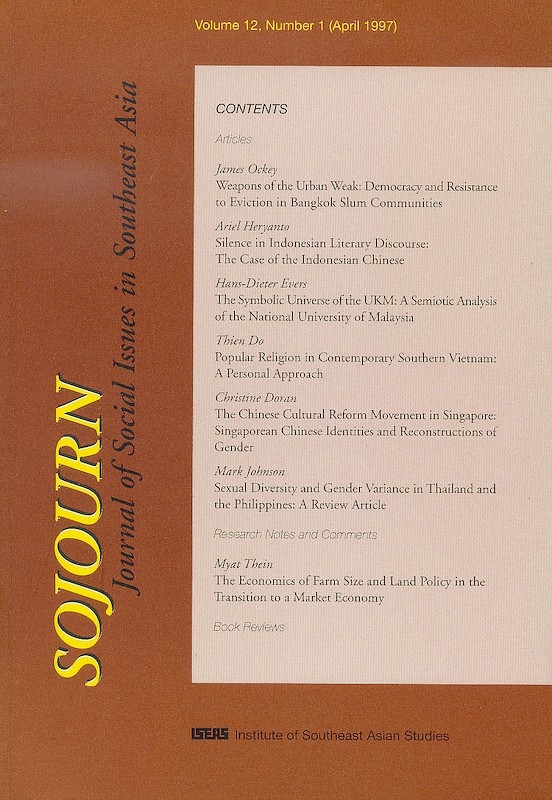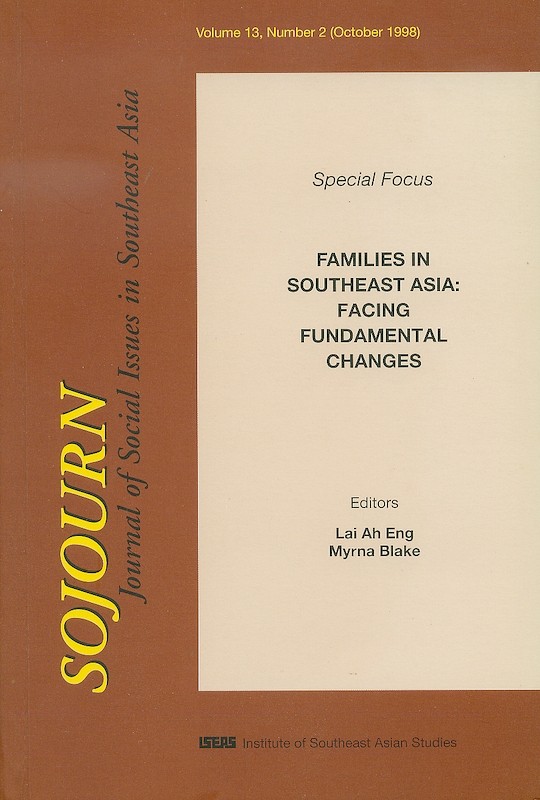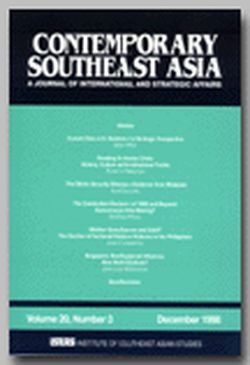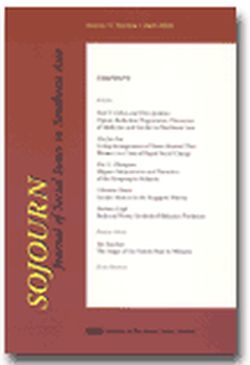SOJOURN: Journal of Social Issues in Southeast Asia Vol. 11/2 (Oct 1996)
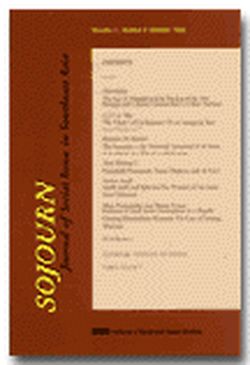
Date of publication:
October 1996
Publisher:
Institute of Southeast Asian Studies
Number of pages:
181
Code:
SJ11/2
Contents
-
Preliminary pages
-
The Rise of Moradok and the Decline of the Yarn: Heritage and Cultural Construction in Urban Thailand, by Marc Askew, contributor see abstractMoradok, the Thai word customarily used to refer to property inheritance, has entered into professional, media, and policy discourse over the last two decades in Thailand to connote public cultural heritage. This represents a trend in cultural policy which reflects internal social and cultural anxieties stemming from the ³development decades² as well as international stimuli. This discussion examines the issue of urban heritage and cultural identity in Thailand and some of the key trends informing state cultural policy from the nineteenth century. It then follows with an account of efforts to plan for the redevelopment and rehabilitation of ³Rattanakosin Island² (the old inner royal precinct of Bangkok, or Krung Thep) in the context of Thai professionals¹ concerns for retaining exemplary architectural specimens and evocative vistas and the Thai state¹s need for promoting a coherent ⹠even if very partial and flawed ⹠sense of the urban past in a time of rapid modernization. At the same time, however, the landscapes of the common neighbourhood and market areas (or yarn) of Bangkok are being sacrificed, a key cultural contradiction in the development process. While an alternative view of heritage has emerged in Thailand which stresses the importance of local community (chumchon), particularly in the rural areas, the strength of prevailing urban development ideology and the sheer material force of urban change are calculated to demolish remaining vestiges of the ordinary landscapes of Bangkokians.
-
The "Clash" of Civilizations? Or an Emerging "East Asian Modernity"?, by C J W-L Wee, contributor see abstractThis paper examines Samuel Huntington¹s influential article, ³The Clash of Civilizations?², particularly his interest in ³Confucian² civilizations. Huntington¹s ³civilizational² approach, this paper suggests, is marred by ahistorical and essentialist thinking on both the causes of the emergence of East and Southeast Asian newly industrializing economies (NIEs) and the reasons for the clashes between East and West in recent years. What is at stake instead is to a large measure a question of what an ³East Asian modernity² (often conceived of as a neo-Confucian modernity) might look like, and whether the NIEs have achieved such a modernity that could be an alternative to the Western version of it. The latter modernity could then no longer claim a universal standard. The creation of an Asian rather than Asianized modernity, further, would mark the arrival of post-colonial countries such as Malaysia and Singapore in the world; thus some argue, the East finally would have nearly eradicated the memory of what is called the ³Age of Empire². In this manner, East Asian modernity discourse functions as a successor to earlier anti-imperial and nationalist discourses.
-
The Peasantry as the Territorial Spearhead of the State in Southeast Asia: The Case of Vietnam, by Rodolphe De Koninck, contributor see abstractThroughout history, peasant communities have been involved in forms of land pioneering which have contributed to the territorial formation and consolidation of states. This has been facilitated by a compromise between the builder-administrators of the states and the peasants themselves in their capacity as guardian-prisoners of the territory. This compromise, through which the state gains territorial legitimacy by protecting and administering newly established peasant domains, has been and remains exceptionally dynamic in Southeast Asia. Examples are provided concerning Burma, Thailand, the Philippines, Malaysia, Indonesia and, particularly, Vietnam. Between the historical southward drive of the Viet people, from the Red River delta to that of the Mekong, which began as early as the tenth century and lasted through the eighteenth, and the contemporary westward drive to the Central Highlands, there is a thread. From Nam Tiên to Tay Tiên, this thread is drawn by the Vietnamese peasantry which acts as the territorial spearhead of the Vietnamese state. It implies the integration of peripheral and marginal lands and their inhabitants, particularly minority people.
-
Household Formation, Private Property, and the State, by Tania Murray Li, contributor see abstractAssuming that households are not ³natural² units, it is important to explore the processes through which the exterior boundaries and internal dynamics of households are formed and transformed in particular agrarian contexts. This paper examines the impact of two such processes: the privatization of agricultural land, which encloses individuals within households and restricts the range of relationships through which they can access resources; and interventions by the state, both ideological and administrative in nature, which aim to reform households as units of ownership and control. These processes are explored through a review of literature from Europe, Africa, and Southeast Asia, then examined in detail in a case-study from the Tinombo hills of Central Sulawesi. Rejecting the notion that there is a pre-determined trajectory of household development or agrarian change, emphasis is given to the creative, generative dimension of cultural practice which produces particular (partial) resolutions.
-
Global and Local Spheres: The Diversity of Southeast Asian Urbanism, by Rudiger Korff, contributor see abstractUrbanism in Southeast Asia is often depicted as a process involving the struggle of different actors attempting to consciously shape the city or make an impact through their daily activities. With the rapid expansion of business centres as a result of globalization, the value of land has increased rapidly. It becomes difficult to justify the use of prime land for cheap accommodation, and the eviction of squatters is now a common occurrence in all larger Southeast Asian cities. Responses by the people and the organization of resistance against eviction attempts differ quite markedly among Southeast Asian cities. They vary according to the political and administrative environment as well as the economic, social, and cultural organizational networks existing in kampung and slum areas. Additionally, they are also affected by the processes of globalization, specifically by the emergence and growing importance of the middle class and demands for democratization. In this regard, the analysis of conflicts related to eviction provides an insight into the dynamics of urban politics. As will be shown, this is closely linked to the social organization of slum and kampung communities. Such an analysis highlights the specifics of primate cities in Southeast Asia, which forms an important aspect of urban change often neglected in studies of urban management and urban planning.
-
Problems of Small Town Development in a Rapidly Growing Metropolitan Economy: The Case of Soreang, West Java, by Hastu Prabatmodjo, Tommy Firman, contributors see abstractThis paper examines the socio-economic and physical development of the small town of Soreang in the Bandung Metropolitan Area (BMA). It also analyses the effectiveness of the counter-magnet policy in dealing with the problem of spatial disparity. Both Bandung city and Soreang town are being physically integrated and the rapidly growing Bandung-Soreang corridor is increasingly utilized for socio-economic activities in the BMA.
-
BOOK REVIEW: Indonesian Cinema: Framing the New Order, by Krishna Sen
-
BOOK REVIEW: Bewitching Women, Pious Men: Gender and Body Politics in Southeast Asia, edited by Aihwa Ong and Michael G. Peletz, by William Wilder, contributor
-
BOOK REVIEW: The Austronesians: Historical and Comparative Perspectives, edited by Peter Bellwood, James J. Fox, and Darrell Tryon, by Victor T King, contributor
-
BOOK REVIEW: The Golden Peninsula: Culture and Adaptation in Mainland Southeast Asia, by Charles F. Keyes, by Jonathan Rigg, contributor
-
Conferences, Workshops, and Seminars
-
Index to Volume 11

